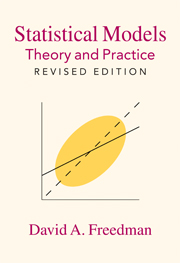Book contents
- Frontmatter
- Contents
- Foreword to the Revised Edition
- Preface
- 1 Observational Studies and Experiments
- 2 The Regression Line
- 3 Matrix Algebra
- 4 Multiple Regression
- 5 Multiple Regression: Special Topics
- 6 Path Models
- 7 Maximum Likelihood
- 8 The Bootstrap
- 9 Simultaneous Equations
- 10 Issues in Statistical Modeling
- References
- Answers to Exercises
- The Computer Labs
- Appendix: Sample MATLAB Code
- Reprints
- Index
Foreword to the Revised Edition
Published online by Cambridge University Press: 05 June 2012
- Frontmatter
- Contents
- Foreword to the Revised Edition
- Preface
- 1 Observational Studies and Experiments
- 2 The Regression Line
- 3 Matrix Algebra
- 4 Multiple Regression
- 5 Multiple Regression: Special Topics
- 6 Path Models
- 7 Maximum Likelihood
- 8 The Bootstrap
- 9 Simultaneous Equations
- 10 Issues in Statistical Modeling
- References
- Answers to Exercises
- The Computer Labs
- Appendix: Sample MATLAB Code
- Reprints
- Index
Summary
Some books are correct. Some are clear. Some are useful. Some are entertaining. Few are even two of these. This book is all four. Statistical Models: Theory and Practice is lucid, candid and insightful, a joy to read. We are fortunate that David Freedman finished this new edition before his death in late 2008. We are deeply saddened by his passing, and we greatly admire the energy and cheer he brought to this volume—and many other projects—during his final months.
This book focuses on half a dozen of the most common tools in applied statistics, presenting them crisply, without jargon or hyperbole. It dissects real applications: a quarter of the book reprints articles from the social and life sciences that hinge on statistical models. It articulates the assumptions necessary for the tools to behave well and identifies the work that the assumptions do. This clarity makes it easier for students and practitioners to see where the methods will be reliable; where they are likely to fail, and how badly; where a different method might work; and where no inference is possible—no matter what tool somebody tries to sell them.
Many texts at this level are little more than bestiaries of methods, presenting dozens of tools with scant explication or insight, a cookbook, numbers-are-numbers approach. “If the left hand side is continuous, use a linear model; fit by least-squares. If the left hand side is discrete, use a logit or probit model; fit by maximum likelihood.”
Information
- Type
- Chapter
- Information
- Statistical ModelsTheory and Practice, pp. xi - xiiPublisher: Cambridge University PressPrint publication year: 2009
